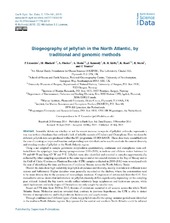| dc.description.abstract | Scientific debate on whether or not the recent increase in reports of jellyfish outbreaks represents a true rise in their abundance has outlined a lack of reliable records of Cnidaria and Ctenophora. Here we describe different jellyfish data sets produced within the EU programme EURO-BASIN. These data were assembled with the aim of creating an improved baseline and providing new data that can be used to evaluate the current diversity and standing stocks of jellyfish in the North Atlantic region. Using a net adapted to sample gelatinous zooplankton quantitatively, cnidarians and ctenophores were collected from the epipelagic layer during spring–summer 2010–2013, in inshore and offshore waters between lat 59 and 68° N and long 62° W and 5° E. Jellyfish were also identified and counted in samples opportunistically collected by other sampling equipment in the same region and at two coastal stations in the Bay of Biscay and in the Gulf of Cádiz. Continuous Plankton Recorder (CPR) samples collected in 2009–2012 were re-analysed with the aim of identifying the time and location of cnidarian blooms across the North Atlantic Basin. Overall the data show high variability in jellyfish abundance and diversity, mainly in relation to different water masses and bathymetry. Higher densities were generally recorded on the shelves, where the communities tend to be more diverse due to the presence of meropelagic medusae. Comparison of net records from the G.O. Sars transatlantic cruise shows that information on jellyfish diversity differs significantly depending on the sampling gear utilised. Indeed, the big trawls mostly collect relatively large scyphozoan and hydrozoan species, while small hydrozoans and early stages of Ctenophora are only caught by smaller nets. Based on CPR data from 2009 to 2012, blooms of cnidarians occurred in all seasons across the whole North Atlantic Basin. Molecular analysis revealed that, contrary to previous hypotheses, the CPR is able to detect blooms of meroplanktonic and holoplanktonic hydrozoans and scyphozoans. Through combination of different types of data, key jellyfish taxa for the spring–summer period were identified in the northern North Atlantic regions. Key species for the central and southern North Atlantic could be inferred based on the blooms identified by the CPR survey, although this should be confirmed further by comparison with quantitative data. The identification by DNA barcoding of 23 jellyfish specimens collected during the EURO-BASIN cruises contributes to increasing the still very limited number of jellyfish sequences available on GenBank. | en_US |

